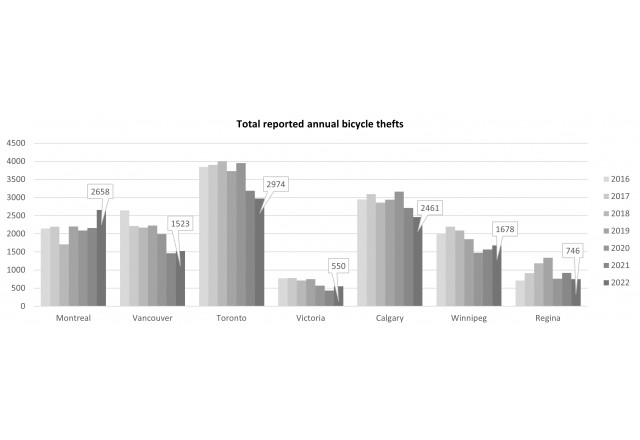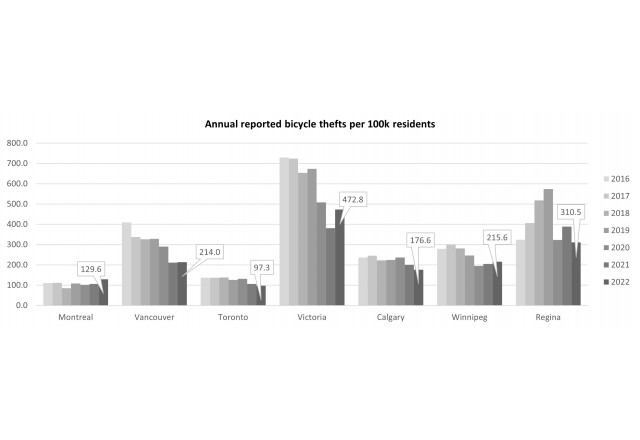Square One Warns That Summer Brings a 429% Increase in Bicycle Thefts

VANCOUVER, British Columbia, July 4, 2023 (Newswire.com) - Hot weather has arrived, and Canadians are breaking out their bicycles. It's no surprise that more bicycles in use means more reported thefts, but Square One found that the number of thefts during the summer months was 429% greater than winter—a tremendous difference. Square One reached out to police services in several major cities across Canada for detailed data on reported bike thefts, including Victoria, Vancouver, Calgary, Regina, Winnipeg, Toronto, and Montreal.
After combining the data from these cities, it was noteworthy that reported bicycle thefts have declined sharply in several cities since 2016. Even adjusting for population growth, theft rates declined in most cities over that time span. However, four of the seven cities saw an increase in 2022 compared to 2021.
The two smallest cities in the dataset had the highest population-adjusted theft rate. This may be simply a result of a small sample size. However, at least in Victoria's case, year-round cycling is far more common. Reported thefts during Victoria's summers were only 81% higher than during winter—compared to 429% for all cities combined—which suggests fewer bicycles are taken out of use seasonally and more year-round work for thieves.
In any case, bicycle theft remains an issue in each city, and summer weather means more thieves are on the lookout for opportunities. While not every police department reported theft locations in the same way (or at all), Square One amalgamated the reported locations from which bikes were stolen. Out of almost 75,000 reported thefts from 2016 to 2022 in Victoria, Vancouver, Calgary, Winnipeg, and Toronto, here are the most common theft locations and the percentage of thefts reported from each:
- Residential property: 43.4%
- Out-and-about (parks, streets, etc.): 30.3%
- Commercial property: 15.5%
- Other: 6.0%
- Educational facilities: 3.4%
- Transit (bus, station, train): 1.4%
Almost half of the thefts took place at home, including frequent thefts from inside sheds or garages. Vancouver was the only city where this wasn't true—bicycles were more commonly reported stolen from streets or parks.
Knowing this, what is one to do? It's important to take proper steps to prevent your bicycle from becoming one of these statistics:
- Invest in a proper lock. For example, U-locks made of hardened steel. Consider combining multiple types of locks, too—the longer it would take a thief to cut or break them, the more likely they are to move on to the next target.
- Register your bicycle. Project 529 is a program that partners with many law enforcement agencies and allows bicycle owners to register their ride for free. Many local law enforcement services, including the Toronto Police Service, have registration programs as well. Record the bike's serial number and take photos so you can easily identify it.
- When parking your bicycle, choose a rack securely fastened to the ground or a building. A good rack allows you to secure both wheels and the frame. Try to park in a secure area with limited access or, failing that, an area with plenty of foot traffic. Don't leave accessories or bags with your bike when you park it.
Despite preventative measures, bicycles can still get stolen. Depending on the city, fewer than 5 percent are ever returned to their owners. In the worst-case scenario, owners of stolen bicycles can claim the loss through their home insurance if they've purchased appropriate coverage.
"Many home insurance policies automatically include $1,000 to $3,000 worth of bicycle coverage but require specific coverage for bicycles worth more," says Stefan Tirschler, Director, Product + Underwriting at Square One. "Square One offers the option to include as much bicycle coverage as the policyholder wishes; only bicycles worth over $3,000 need to be specifically listed. And, customers who don't have a bike can decline bicycle coverage entirely to save a few dollars every month."
To learn more about bicycle insurance options, speak with your insurance provider or visit squareone.ca
Source: Square One Insurance Services


